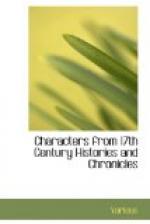Page 194, ll. 28 ff. Edward Millington’s place of business was ’at the Pelican in Duck Lane’ in 1670; from Michaelmas, 1671, it was ’at the Bible in Little Britain’ (see Arber’s Term Catalogues, vol. i, pp. 31, 93). It was about 1680 that he turned auctioneer of books, though he did not wholly abandon publishing. ’There was usually as much Comedy in his “Once, Twice, Thrice”, as can be met with in a modern Play.’ See the Life and Errors of John Dunton, ed. 1818, pp. 235-6. He died at Cambridge in 1703.
Page 196, l. 4. Dr. Tancred Robinson (d. 1748), physician to George I, and knighted by him.
l. 10. Henry Bendish (d. 1740), son of Bridget Ireton or Bendish, Cromwell’s granddaughter: see Letters of John Hughes, ed. John Duncombe, vol. ii (1773), pp. x, xlii.
l. 14. John Thurloe (1616-68), Secretary of State under Cromwell. Compare No. 38 note.
l. 25. ‘Easy my unpremeditated verse’, Paradise Lost, ix. 24.
60.
The Works of M’r Abraham Cowley. Consisting of Those which were formerly Printed: and Those which he Design’d for the Press, Now Published out of the Authors Original Copies. London, 1668.—’Several Discourses by way of Essays, in Verse and Prose,’ No. II. (pp. 143-6.)
Cowley’s Essays were written towards the close of his life. They were ‘left scarce finish’d’, and many others were to have been added to them. They were first published posthumously in the collected edition of 1668, under the superintendence of Thomas Sprat (see No. 61). This edition, which alone is authoritative, has been followed in the present reprint of the eleventh and last Essay, probably written at the beginning of 1667.
Page 198, l. 1. at School, Westminster.
ll. 19 ff. The concluding stanzas of ‘A Vote’, printed in Cowley’s Sylva, 1636. Cowley was then aged eighteen. The first stanza contains three new readings, ‘The unknown’ for ‘Th’ ignote’, ’I would have’ for ‘I would hug’, and ‘Not on’ for ‘Not from’.
Page 199, l. 15. out of Horace, Odes, iii. 29. 41-5.
Page 200, l. 4. immediately. The reading in the text of 1668 is ‘irremediably’, but ‘immediately’ is given as the correct reading in the ‘Errata’ (printed on a slip that is pasted in at the conclusion of Cowley’s first preface). The edition of 1669 substitutes ‘immediately’ in the text. The alteration must be accepted on Sprat’s authority, but it is questionable if it gives a better sense.
ll. 6-10. Cowley was admitted to Trinity College, Cambridge, as a Westminster scholar on June 14, 1637. He was admitted Minor Fellow in 1640, and graduated M.A. in 1643. He was ejected in the following year as a result of the Earl of Manchester’s commission to enforce the solemn League and Covenant in Cambridge. See Cowley’s Pure Works, ed. J.R. Lumby, pp. ix-xiii, and Johnson’s Lives of the Poets, ed. G.B. Hill, vol. i, p. 5.




